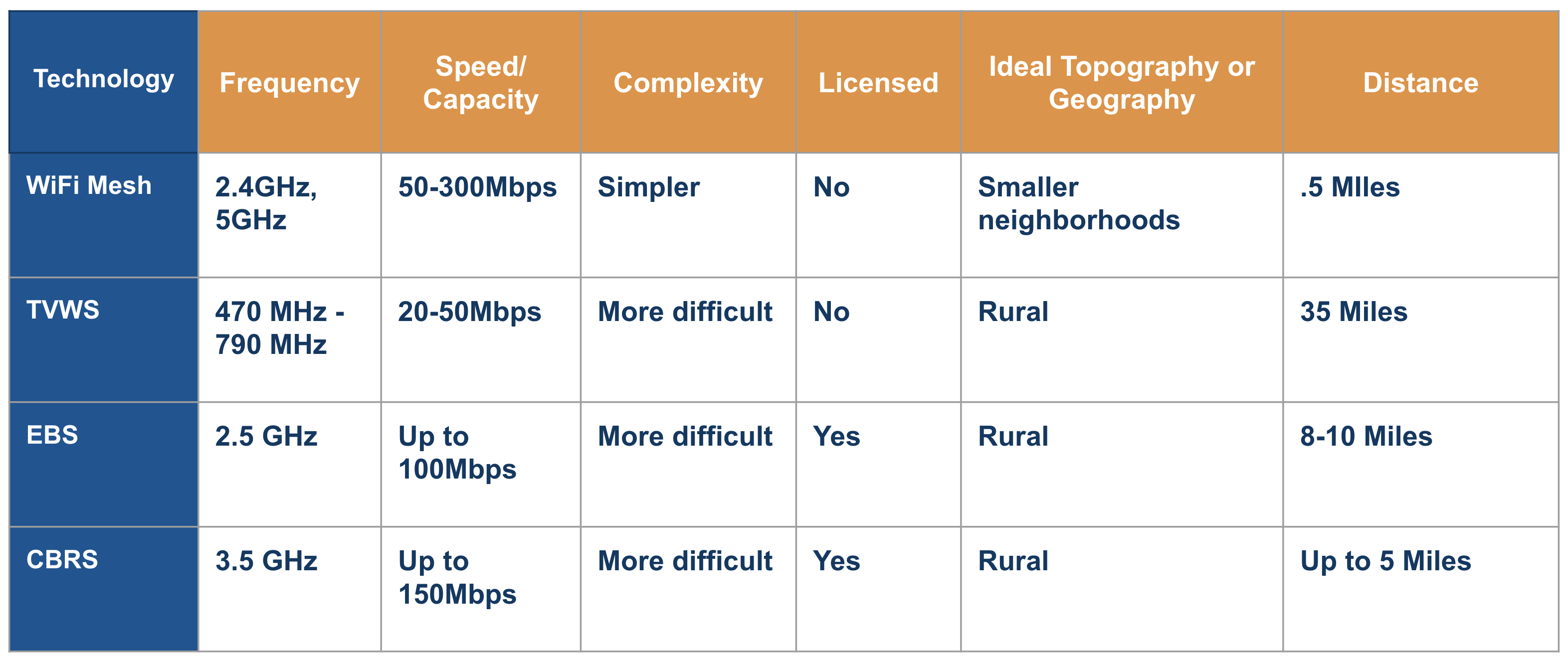- About
- Network
- Community
- Initiatives
- News
- Events
- Blog
- Publications

CENIC PERSPECTIVES: Wireless Internet Technologies for Access, Equity, and Continuity
Categories Equity & Access CENIC Perspectives
During the COVID-19 pandemic, broadband Internet connectivity has become essential for the continuity of education, work, and healthcare. Schools, colleges, libraries, and other community anchor institutions have provided many Californians, particularly those who have no broadband access at home, a lifeline. As their constituents are now at home, many CENIC member institutions are looking for ways to extend online connectivity. Equity of broadband access has always been part of CENIC’s mission, values, and strategic goals, particularly at our member institutions in communities that have little or no broadband Internet access.
Wireless technologies have the potential to address many common challenges facing the CENIC community. While CENIC is not providing wireless connections, we have been working with our members, offering our expertise in solving access and equity problems, and providing referrals to our private sector partners with experience in wireless technologies, hoping to assist as school districts, libraries, colleges, and research sites endeavor to extend their services beyond the physical boundaries of their institutions and reach their constituents at home. This article explores wireless technologies that our members are using or could use to address issues such as:
- the K-12 homework gap;
- online learning and remote work during the pandemic and beyond;
- remote diagnosis, treatment, monitoring, and followup for telehealth;
- remote data collection for scientific research; and
- wildfire prevention, early detection, containment, and assessment.
Four wireless options — WiFi mesh, Television White Space (TVWS), Citizens Broadband Radio Service (CBRS), and Educational Broadband Service (EBS) — have risen to the top of feasible solutions. For each one, CENIC engineers explain how the technology works, its advantages and disadvantages, and case studies of successful deployments. Case studies present creative ways to build and pay for wireless technologies as regulations prohibit E-Rate recipients from using subsidized services beyond the institution’s property line.
The Basics
In order to understand each of the wireless technologies, it’s important to first understand spectrum. Wireless communications require the transmission of data over spectrum. There are many everyday use cases that each employ different bands of the spectrum, such as radio, television, cellphones, and the Internet. There are limited amounts of usable bands, and the use of these bands is defined and regulated by the Federal Communications Commission. The key concept to remember about spectrum is that using lower frequencies gains distance but loses speed, while higher frequencies gain speed but lose distance.

WiFi Mesh
The underlying technology of WiFi mesh is the same as everyday WiFi in use at home or work, but scaled up by using outdoor enterprise equipment able to create mesh coverage in an area.
The advantages of WiFi mesh are that it’s an established, easily supported technology that doesn’t require special equipment on the receiver’s end. However, the disadvantages of this technology include that it needs a direct line of sight because the signal is easily obstructed and that capacity decreases quickly with distance from the wired connection. WiFi mesh is a simpler technology than some other wireless options, but it is best suited for smaller neighborhoods, with a range of up to about half a mile and capacity of up to 300 Mbps.
In San Rafael, local government, a community nonprofit, and generous stakeholders came together during the summer of 2020 to build a WiFi mesh network in the city’s Canal neighborhood to connect over 2,000 students and their families in anticipation of the upcoming school year.
Television White Space (TVWS)
In 2009, when the US transitioned from analog to digital TV, unused areas of the TV spectrum were freed up. These available spaces are called TV White Space and can be used to extend wireless Internet connectivity.
The advantages of TVWS are that it has a good range and decent capacity. The disadvantages are that it requires special equipment, finding open airspace can be complex, and interference, from live TV broadcasts on the scene and other area communications, is common. TVWS is typically used in rural areas, as it can cover distances of up to 35 miles with capacity around up to 50 Mbps.
In Huron, South Dakota, the public library used a grant from the Institute of Museum and Library Services to buy and install TV white space base stations that transmit broadband Wi-Fi to remote hotspots placed in the city’s parks. The new network has helped the library reach local immigrants who use the parks but don’t often visit the library.
Educational Broadband Service (EBS)
Educational Broadband Service, or EBS, is a band of spectrum that the FCC originally allocated for educational purposes. In the mid-2000s, the FCC opened up EBS to broadband services, resulting in many EBS license holders leasing out their capacity to commercial 4G wireless providers.
The advantage of EBS is that it may present an affordable wireless connectivity opportunity for educational institutions where EBS licenses remain available. EBS enables high traffic rates and has a relatively low cost for equipment. EBS can reach up to 10 miles with a capacity of 100 Mbps.
In Central California’s Kings County, an agricultural county with few broadband options for families, the County Office of Education used EBS to build a private network. Students can get a handheld Wi-Fi device that they take home. The cost is $10 per month and allows up to six computers with fast access to the Internet.
Citizens Broadband Radio Service (CBRS)
The Citizens Broadband Radio Service, or CBRS, is a band of spectrum that the FCC has established and created a three-tiered access and authorization framework to accommodate shared federal and non-federal use.To use CBRS spectrum, one needs to request and be assigned a band by an automated frequency coordinator, known as a Spectrum Access System (SAS). CBRS is most commonly used to deploy Long-Term Evolution (LTE) networks for cellular devices.
The advantages of CBRS are that it’s affordable, easier to obtain than an EBS, and has more capacity than EBS. The disadvantages are that interference can be present, usage requires communication with an FCC-approved SAS, and it has a limited reach. CBRS extends up to 5 miles with a capacity up to 150 Mbps.
In Salt Lake City, the Murray City School District may be the first school district in the country to build a private CBRS network for its students. The district built a CBRS network using Ruckus radios, an Special Temporary Authority (STA) from the FCC, and General Authorized Access CBRS spectrum. The district bought CBRS radios and used charitable donations to buy hotspots for students.

Leverage CENIC’s Expertise
Activity in the wireless technology arena is significant, and these options may provide CENIC members with cost-effective ways to better connect unserved and underserved communities. While CENIC is not providing these wireless connections, if your organization is thinking about one of these solutions, feel free to contact CENIC to leverage our expertise. Download our wireless technologies presentation to learn more.
Related blog posts
CENIC Members Bolster the Economy by Expanding Digital Literacy in California
Members of CENIC are working to improve digital literacy by supporting initiatives aimed at creating digital access for more Californians and by creating programs to enhance digital literacy once those people have been connected.
Ventura County Library Capitalizes on CENIC Membership to Provide eduroam Connectivity to Student and Faculty Patrons
By becoming eduroam Hotspot Operators, Ventura County Library and its branches offer the extremely valuable service of eduroam connectivity to its student and faculty residents.


